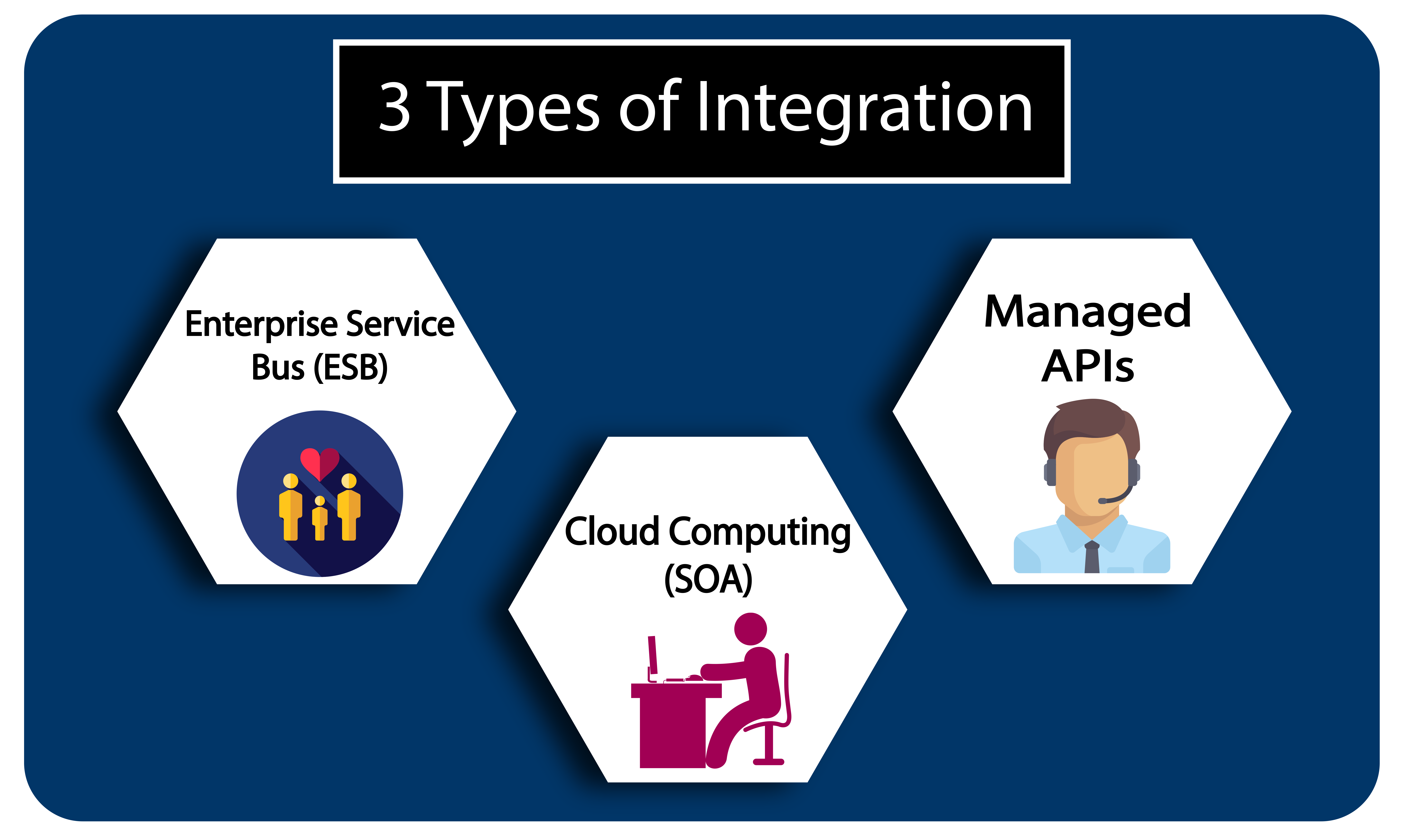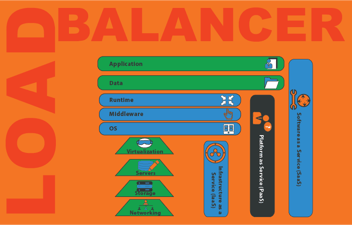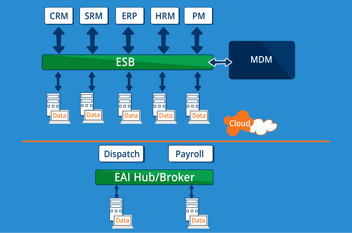Cloud Integration platform
Many enterprises slowly move to cloud computing at their own pace. You do not need to bring all of your IT systems to the cloud. Some sensitive data or legacy applications data can stay within the organization, named as on-premise data. The organization maintains the on-premise data.
The private cloud is the one which is maintained by a third party cloud vendor within the organization. The community cloud runs across organizations and maintained by another party.
Hybrid integration refers to the communication link between your on-premise and your cloud data over your integration platform. The following figure-1 shows high level understanding of the platform. Cloud can be either public or private category.
As per the industry analysts, many firms use this hybrid integration approach. This is to take advantage of the cloud computing space as well as to keep privacy and control over the sensitive data.

Figure-1, Hybrid Integration platform
How does integration happen in a cloud integration platform?
There are several integration patterns, as shown in the Figure-2.
- Service Oriented Architecture (SOA)
- Enterprise Service Bus (ESB)
- Managed APIs

Figure -2 , Types of integration
Figure-2 shows the basis of a hybrid integration platform
According to a new report from Gartner, "By 2019 ... over 85% of new packaged customer service and support software will be delivered on a cloud-based model, and Software-as-a-Service (SaaS) will emerge as an essential selection factor for customer relationship management (CRM) customer engagement centers.”
Service-level Integration (SOA)

Figure -3, Cloud computing Services
Figure-3 shows the relationship between multiple service levels of management in cloud integration platform.
Cloud is a cost effective solution for the enterprise. In addition, it provides Infrastructure-as-a-Service (IaaS), Platform-as-a-Service (PaaS) and Software-as-a-Service (SaaS).
IaaS is the most basic service of a cloud service, which caters for IT infrastructure, servers, virtual machines, storage, networks and operating systems.
PaaS is an on-demand environment for development, testing, delivery and managing the applications. Developers can quickly create web or mobile applications without worrying about the set up. It also inherently uses IaaS.
SaaS cloud providers host and manage the software applications and underlying infrastructure and maintenance. Integration-as-a-Service is needed.
The level to which cloud computing is to be used will be dependant on the sensitivity of the data being stored and on regulatory compliance.
Regulatory Compliance & Security: Some enterprises need to maintain the data on-premise for compliance. Some organizations keep this data on-premise due to security concern. So it is necessary to have a plan of maintaining non-sensitive data in the cloud and sensitive data on-premise. To take advantage of cloud computing it is necessary to connect with cloud.
Best practices of SaaS Integration
SaaS application should be:
- user friendly and self explanatory - the features should be user friendly and understandable without much effort or complexity.
- SaaS application should be customer focussed - standard expectation of features should be available and should satisfy the customers from start to end.
- Users need interactive support and it should be available - interactive support if needed.
- All Frequently asked questions (FAQ) should be answered and kept available - FAQ readily available.
- There should be features for self service and simple guidance.
- Place for feedback - collect feedback from customers for continual correction and progress.
- Single truth communication for follow-up - if customer communicates in multiple channels, SaaS should able to identify the user and answer accordingly.
- Enough standards in process.
- Right team for communication - proactive customer service, build trust with customer.
- Review feedback - user feedback should be monitored and answered in SLA.
- Less downtime - maintenance operations should be notified and fixed in SLA. Stakeholders should be notified with proper communication.
- Bugs, missing features, hidden features should be handled as quick as possible.
- If it is multi-tenant, it is cost effective.
- SaaS should be integrated with other applications.
- SaaS should be in operational performance in SLA.
- SaaS should support compliance board standard rules and regulations.
- Various regulation board organization demands data should be within its prescribed location premises with security.
- SaaS should be maintained and monitored - SaaS should be monitored for lookouts for downtimes and fix.
- Design right message to right user - communication and notifications should be sent to correct users. Application and database ID should be unique at user level.
- Scalability with application - use more powerful servers if required.
- Scalability with database - as demand increases, the capacity of the database should be capable of handling it.
- Support web2.0 features
- Support user interactive messages such as social media, Facebook, Twitter etc.
- Incorporate open source software and services - in addition to vendor software, open source tools also should be available to choose from.
- Utilize agile methodologies in implementation- there must be a place holder for agile methodologies.
References from

Figure 4, SaaS delivery
Figure-4 shows how releases are rolled out in SaaS. Agile methods, tools, and technologies are utilized.
- Develop standard architecture - industry standard features are to be available.
- Incremental releases in software deployment - SaaS should provide enough tools and deployment options for it.
- Develop integration strategy for SaaS application - integration with on premise, back office and cloud network applications are still a challenge. Need to have a proper strategy for integration.
- Integration with a large volume of data - proper estimate is necessary to choose the right tools to handle a larger volume of data.
- Integration on demand / elasticity - as more and more applications are connected, integration of on-demand features should be available. iPaaS (Integration platform as a Service) helps in Integration-as-a-Service.

Figure-5, Elastic Scaling.
Figure 5 shows elastic scaling, one of the very best features of the cloud.
- SOA - as organizations add more and more business and SaaS functionality, Service Oriented Architecture (SOA) governance feature should be utilized.
- Location independence - in the cloud, location is independent.
References:

Figure-6, Enterprise Integrator.
Figure-6 shows how WSO2 Enterprise integrator version 6 works. It comes as a single package with all of these modules and profiles included for enterprise Integration platform.
- ESB Service Integration (WSO2 ESB)
- Message broker (WSO2 MB)
- Business process (WSO2 BPS)
- Micro-services and Analytics.
- Real-time data processing (WSO2 DSS)
- WSO2 Governance registry
- WSO2 business activity monitor (BAM)
- API manager and identity server
ESB connectors are readymade ESB extensions that allow the developer to focus only on the respective business logic. There are more than 150 connectors to connect with SaaS applications, legacy services, on-premise systems, and third-party cloud APIs available in the WSO2 store for cloud integration platform.
WSO2 API Cloud is a public hosted version of open source WSO2 API Manager. It enables enterprises to quickly share their business capabilities with their customers and partners across the globe.
You need to implement a complete identity management solution that ensures secure access to your SaaS apps and safeguards sensitive data that reside in them. You can leverage WSO2 Identity Server capabilities to address the security needs when adopting a SaaS solution and preserve your industry security standards. More information is at WSO2 Library
Why should you integrate your SaaS technologies?
The business world is undergoing a revolution. With the proliferation of technology across our lives and work, industries around the world are realising that the tried and trusted methods that have kept them moving forward might no longer suffice. Consumers today are connected, informed, and unprecedentedly technologically savvy, and as a result, the companies they deal with are expected to be the same.
Digital transformation — the process by which organizations modernize themselves to incorporate new digital technologies throughout their entire business — is becoming necessary to survive.
Modern clients want instant service and support from the brands they deal with. They want brands that make themselves available to the client in a way that suits the client, not in a way that suits the organization. And they want this experience to be offered seamlessly across every channel. In order for an organization to meet these needs and wants of the consumer, it is absolutely necessary for companies to be innovative and to stay abreast of digital updates and changes. With this in mind, decision makers in businesses are emphasizing the need for digital transformation within their organizations.
With the rise of tools such as CRM, ERP, SRP and others, it has become necessary to integrate these tools in order to have a complete view of your customers data and to provide them with the level of service they expect. Using an ESB will ensure all of your tools talk to each other and give you the power to understand your customers and drive your business forwards.
f you know you need to implement an ESB for your organisation, but don't know where to begin or if you just need advice, contact our consultants to discuss your options. We are experts in the area of ESB integration and have worked with many clients to help them succeed.





Leave a Comment